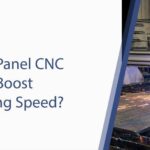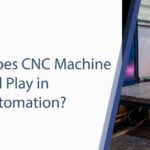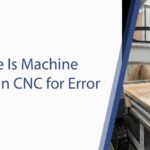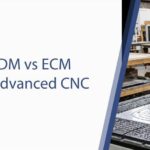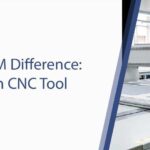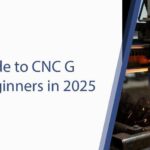The Brains of Precision Machining
The Computer Numerical Control (CNC) control panel stands as the indispensable central nervous system of any modern CNC machine.
Its fundamental purpose is to interpret meticulously programmed instructions, typically in formats like G-code and M-code, and translate them into the precise, automated movements and operations that define contemporary manufacturing.
The journey from basic Numerical Control (CNC) systems to the sophisticated, multi-functional CNC machine control panels available today marks a significant technological leap.
This evolution has not only enhanced the accuracy, speed, and complexity achievable in machining but has also fundamentally reshaped the landscape of industrial production.
Consequently, the selection of an appropriate control panel type is a critical decision for any manufacturing enterprise, directly influencing operational efficiency, machine capability, and overall cost-effectiveness.
In this dynamic field, Radonix Technology has emerged as a key innovator, consistently pushing the boundaries of CNC control. With a commitment to providing advanced, reliable, and often PC-based control solutions, Radonix empowers manufacturers with powerful and adaptable systems tailored to diverse industrial needs.
For over 15 years, Radonix Innovation has combined industry expertise with cutting-edge technology to deliver smart, affordable CNC controllers designed for high precision and easy integration, underscoring their role in the ongoing advancement of manufacturing technology.
The progression of control panel technology itself mirrors the broader trends of digitalization and automation characterizing Industry 4.0.
As manufacturing demands grow for increasingly intricate parts, higher precision, and greater efficiency, control panels have evolved from simple command interpreters to intelligent hubs incorporating network connectivity, advanced user interfaces, and sophisticated data processing.
This makes the control panel not merely a component, but a crucial enabler of smart manufacturing.
Therefore, choosing the right control panel is a strategic imperative that can significantly impact a company’s competitive standing by optimizing machine performance, enabling more complex operations, reducing training overheads, and minimizing costly downtime.
Fundamental Ways to Categorize CNC Control Panels
Understanding the diverse landscape of CNC control panels begins with recognizing the fundamental ways they are categorized.
These classifications help in aligning the controller’s capabilities with specific application requirements and performance expectations.
A. By Control Loop Architecture: Open-Loop vs. Closed-Loop Systems
A primary distinction in CNC control systems lies in their control loop architecture: open-loop or closed-loop.
Open-loop systems operate by sending command signals to the machine’s motors without receiving confirmation or feedback on whether the command was executed accurately or if the desired position was achieved.
These systems are generally simpler and less expensive, making them suitable for applications where the absolute highest precision is not the paramount concern, or where stepper motors, known for their inherent positional accuracy under defined loads, are employed.
Conversely, closed-loop systems incorporate feedback devices such as encoders or resolvers. These devices continuously monitor the actual position and velocity of the machine axes and report this information back to the controller.
This feedback loop allows the controller to detect any discrepancies between the commanded and actual positions and make real-time corrections.
Consequently, closed-loop systems offer significantly higher accuracy, robust error compensation, and are indispensable for demanding tasks, high-speed machining, or when servo motors are used.
It’s noteworthy that many PC-based CNC systems, including some configurations utilizing Radonix controllers, may operate with an open-loop communication channel between the PC and the controller hardware itself; for instance, Radonix PC-Pro LAN series controllers are specified with “Loop-open control”.
However, these systems are often paired with servo motors that have their own integrated closed-loop feedback mechanisms at the drive level, ensuring precise motor control despite the nature of the PC-to-controller communication.
This approach represents a critical cost-performance trade-off.
While fully closed-loop systems that feed information directly back to the central PC can be complex and costly, leveraging the local closed-loop capabilities of modern servo drives allows PC-based systems like those from Radonix to offer a balanced solution, combining the cost-effectiveness and flexibility of PC control with the high precision of servo-driven motion.
B. By Motion Control Strategy: Point-to-Point vs. Contouring Systems
CNC control panels can also be differentiated by their motion control strategy, primarily categorized as Point-to-Point (PTP) or Contouring (Continuous Path) systems.
PTP systems are designed to move the machine tool rapidly from one programmed point to another. Machining operations, such as drilling, tapping, or punching, are performed only when the tool is stationary at these defined coordinates.
The exact path taken between these points is generally not controlled with precision.
Contouring systems, on the other hand, are significantly more sophisticated. These controllers can generate coordinated movement along multiple axes simultaneously to follow a precisely defined path, which can include straight lines, arcs, and complex curves, all while maintaining a controlled feed rate.
This capability is fundamental for operations like milling intricate profiles, turning complex shapes, and 3D machining. The vast majority of modern CNC controllers, including the comprehensive range offered by Radonix Technology, are equipped with contouring capabilities.
Radonix controllers, for example, support “independent and interpolated axes,” which is the cornerstone of effective contouring, allowing for complex motion patterns and enhanced machining precision.
The widespread availability of contouring capabilities, even in affordable PC-based controllers such as those from Radonix, has effectively democratized complex machining.
Historically, such advanced path control was a hallmark of high-end, expensive controllers. However, the substantial processing power of contemporary PCs enables the implementation of sophisticated interpolation algorithms in a cost-effective manner, making advanced contouring accessible to a broader spectrum of users and applications, including small and medium-sized enterprises (SMEs).
C. By Axis Configuration: From 2-Axis to Multi-Axis Control
The number of axes a CNC control panel can manage is another crucial classification, directly impacting the complexity of parts a machine can produce. Common configurations include:
- 2-Axis (X, Y): Typically found on simple lathes for turning operations or basic cutting machines. Radonix offers 2-axis controllers for such applications.
- 2.5-Axis: These systems control movement along the X, Y, and Z axes. However, the Z-axis movement is generally for setting depth and does not engage in simultaneous contouring with the X and Y axes.
- 3-Axis (X, Y, Z): Allows for simultaneous, coordinated movement in three linear dimensions. This is a very common configuration for milling machines, routers, and general machining centers. Radonix provides several 3-axis controllers, such as the PC Smart 3AS.
- 4-Axis (X, Y, Z + 1 rotary axis, e.g., A or B): The addition of a rotary axis enables machining on multiple faces of a workpiece in a single setup or performing cylindrical machining operations. Radonix’s portfolio includes 4-axis controllers like the PC Smart 4A and PC Pro LAN 4A.
- 5-Axis (X, Y, Z + 2 rotary axes, e.g., A & C, or B & C): These advanced systems facilitate the machining of highly complex geometries, undercuts, and intricate surfaces, often in a single clamping. This reduces setup time, minimizes cumulative errors, and improves surface finish. Radonix also lists 5-axis CNC capabilities.
- 6-Axis and Beyond: Control for six or more axes is typically reserved for highly specialized manufacturing tasks, complex tool path manipulations, or robotic applications. Radonix offers 6-axis controllers like the PC Smart 6A and PC Pro LAN 6A.
Radonix Technology demonstrates a comprehensive approach to axis control with a diverse product range. This includes dedicated controllers for various axis counts and the notably versatile X4 expandable CNC controller, which can manage from 1 to 4 axes, providing scalability.
This diversity in axis offerings, particularly the adaptable X4 controller, signals a strategic focus on providing solutions that can evolve with a customer’s changing requirements or cater to a wide spectrum of machine builders.
While simpler 2 or 3-axis controllers address cost-sensitive needs, the availability of 4, 5, and 6-axis options meets demands for more intricate machining.
The modularity of a controller like the X4 offers significant investment protection and flexibility, allowing users to scale their capabilities without necessitating a complete controller overhaul.
Core Technologies Shaping CNC Control Panels
The functionality and performance of CNC control panels are profoundly influenced by the underlying core technologies. Two dominant architectures, PC-based and embedded systems, along with the evolution of the user interface, define the modern control landscape.
A. PC-Based CNC Controllers: Flexibility and Power
PC-based CNC controllers are systems that utilize a standard personal computer (PC) or an industrial PC (IPC) as the primary processing unit and Human-Machine Interface (HMI).
These PCs typically work in conjunction with specialized motion control cards or external interface boards that handle the real-time aspects of machine control.
This architecture offers several compelling advantages.
Leveraging commodity PC hardware often translates to lower initial costs compared to fully proprietary systems. PCs bring powerful processing and graphics capabilities, enabling sophisticated user interfaces, on-screen simulations, and the ability to handle large, complex part programs.
Users often benefit from a familiar operating environment, such as Windows, which can reduce the learning curve.
Furthermore, PC-based systems generally offer excellent networking capabilities, facilitating easy integration into plant-wide data systems, and provide greater flexibility in software choices, sometimes allowing CAM software or other manufacturing tools to run on the same platform.
While early PC-based systems sometimes faced scrutiny regarding real-time performance and stability, modern iterations, particularly those using high-performance PCs and dedicated interface hardware, have largely overcome these concerns.
Radonix Technology is a prominent proponent of this architecture, with its PC Smart and PC Pro LAN series of controllers exemplifying the capabilities of modern PC-based CNC control.
These Radonix systems boast features such as high axis pulse rates (up to 100,000 pulses per second for the PC-Smart 3AS and up to 500,000 pulses per second for the PC Pro LAN series), S-Curve acceleration profiles for smoother motion, robust TCP/IP communication over LAN, and ample digital and analog input/output (I/O) capabilities.
Radonix’s strategic emphasis on high-performance PC-based controllers allows them to deliver features and capabilities that rival some dedicated embedded systems but with enhanced flexibility and often at a more attractive price point.
This approach appeals to Original Equipment Manufacturers (OEMs) and end-users alike who seek modern, adaptable, and powerful control solutions.
The evolution of PC hardware continually provides increased processing power at diminishing costs.
Radonix’s controller boards effectively act as specialized co-processors or interfaces, offloading the critical real-time motion control tasks, while the PC manages the HMI, program management, networking, and other higher-level functions.
This synergistic combination enables Radonix to deliver robust performance suitable for demanding industrial environments without the higher costs associated with the custom hardware of fully embedded systems.
B. Embedded CNC Controllers: Dedicated Performance
Embedded CNC controllers are characterized by their use of custom-designed hardware and proprietary software or operating systems, all dedicated exclusively to CNC tasks.
Well-known examples in this category include systems from Fanuc and Siemens.
These controllers are typically engineered for high reliability and optimized real-time performance, often demonstrating exceptional robustness in harsh industrial environments. Their dedicated nature means that all system resources are focused on the control task, leading to predictable and consistent behavior.
However, this specialization can also come with certain trade-offs. Embedded controllers are generally more expensive due to the custom hardware and software development involved. They may offer less flexibility in terms of hardware modifications or software integration compared to PC-based systems.
Programming can sometimes be tied to proprietary languages or specific G-code dialects, and upgrades or repairs might be costlier and dependent on the vendor. While Radonix primarily champions PC-based solutions, some of their product descriptions, such as for the “XYZ Plasma” controller, use the term “compact, embedded”.
It is important to interpret this in context. This likely refers to the controller’s compact physical design, allowing it to be easily embedded or integrated within a machine’s structure, rather than indicating an embedded system in the traditional OS/hardware architecture sense.
These Radonix units still leverage the control and interface capabilities of a connected PC. This nuanced use of “embedded” by Radonix highlights an appeal that combines the physical integration and robustness often associated with traditional embedded units with the inherent flexibility and advanced interface capabilities of PC-based control.
They are designed as compact hardware modules that facilitate seamless integration into machine enclosures, offering a clean and robust setup without sacrificing the advantages of PC control.
C. The User Interface Evolution: From Buttons to Touchscreens
The interface through which operators interact with CNC machines has undergone a dramatic transformation. Traditional control panels are characterized by an array of physical buttons, rotary knobs, selector switches, and often segmented digital readouts or monochrome CRT screens.
The advantages of these classic interfaces include their tactile feedback, proven durability, and reliability, especially in demanding industrial environments where exposure to dust, grease, or vibration is common.
However, they can be less intuitive, often requiring significant operator training and memorization of functions. Information display is typically limited, and data entry for program parameters or offsets can be cumbersome.
In stark contrast, modern CNC control panels increasingly feature graphical, touchscreen-based Human-Machine Interfaces (HMIs). This shift mirrors the user interface paradigms common in consumer electronics like smartphones and tablets.
The benefits are substantial: touchscreen HMIs are generally more intuitive, offering a visually rich experience with larger display areas capable of showing detailed graphics, program simulations, real-time machining status, and diagnostic information.
Navigation is often simplified through menus and icons, and layouts can sometimes be customized to suit specific tasks or operator preferences.
The physical complexity of the panel itself is reduced, leading to cleaner designs.
Advanced features such as multi-touch gestures, on-screen keyboards for easier data entry, and the ability to display real-time performance data are also common.
PC-based control systems, such as those developed and promoted by Radonix, naturally lend themselves to the adoption of these advanced HMI touchscreen displays, as the PC can readily drive standard touchscreen monitors.
Radonix software, designed to run on Windows operating systems, would be interacted with via the PC’s display, making the integration of touch functionality straightforward.
This adoption of HMI touchscreens, greatly facilitated by PC-based control architectures, significantly lowers the barrier to entry for operating complex machinery.
It improves overall operator efficiency and decision-making by providing a more accessible, interactive, and information-rich control environment, leading to faster training, fewer operational errors, and enhanced productivity.
To further clarify the distinctions between these core technologies, the following tables provide comparative overviews:
Table 1: PC-Based vs. Embedded CNC Controllers: A Comparative Overview
| Feature | PC-Based CNC Controllers (e.g., Radonix PC Smart/Pro LAN) | Traditional Embedded CNC Controllers (e.g., Fanuc, Siemens) |
| Hardware | Standard PC/Industrial PC components, specialized interface cards | Custom-designed, proprietary hardware |
| Software/OS | Standard OS (e.g., Windows for Radonix), versatile software options | Proprietary OS and software |
| Programming | Standard languages (G-code, M-code), often easier to integrate with CAM | Proprietary languages/G-code, may require specific training |
| Flexibility | High; adaptable to various machines, easier software/hardware upgrades | Lower; often machine-specific, upgrades tied to vendor |
| User Interface | Leverages PC capabilities for rich graphical HMI, touchscreens | Often integrated, can range from button-based to proprietary touchscreens |
| Connectivity | Excellent; easy network integration (e.g., TCP/IP for Radonix), data exchange | Can be limited or proprietary, though improving |
| Cost | Generally lower initial cost, uses commodity hardware | Higher initial cost due to custom hardware/software |
| Real-time Perf. | Good to Excellent with modern PCs & dedicated cards (Radonix high pulse rates) | Optimized for real-time, highly reliable |
| Radonix Example | PC Smart Series, PC Pro LAN Series | N/A |
Table 2: Traditional Button Panels vs. Modern HMI Touchscreens
| Feature | Traditional Button-Operated Panels | Modern HMI Touchscreen Panels |
| User Interface | Physical buttons, knobs, switches, limited digital readouts | Graphical, intuitive, touch-based (like tablets) |
| Information Display | Limited, often text/numeric | Rich, detailed visualizations, graphs, simulations |
| Ease of Use | Less intuitive, may require more training | More intuitive, reduced learning curve |
| Customization | Low; fixed layout | High; programmable, adaptable layouts |
| Data Entry | Manual, can be cumbersome | Easier, often with on-screen keyboards, direct interaction |
| Durability | Generally high, robust in harsh environments | Improving, industrial-grade touchscreens available, but can be more sensitive than buttons |
| Complexity (Panel) | Higher physical component count | Lower physical component count, cleaner design |
| Advanced Features | Limited | Real-time data, multi-touch, gesture control, remote access capabilities |
| Integration w/ PC | Can be part of older systems or simpler embedded systems | Natural fit for PC-based control systems (like those offered by Radonix) |
Tailoring Control Panels to CNC Machine Types
While general control principles apply broadly, specific CNC machine types often have unique operational requirements that necessitate tailored control panel features and layouts. Effective control solutions are frequently optimized for the particular machining process they govern.
A. Milling Machine Control Panels: Essential Functions and Layouts
Control panels for CNC milling machines typically provide a comprehensive set of functions to manage multi-axis movement and cutting operations.
Essential features include clear displays for the current position of the X, Y, and Z axes (and any rotary axes), along with controls and overrides for spindle speed and tool feed rates.
Operators need access to program displays to monitor G-code execution, tool management functions for selecting and offsetting tools, and manual jog controls for precise positioning during setup.
Mode selection is critical, allowing shifts between automatic program execution (Auto), Manual Data Input (MDI) for entering single G-code blocks, Edit mode for program modifications, and Jog mode.
Standard safety features like an emergency stop button, cycle start, and feed hold are invariably present. For instance, common keys on a milling control panel include ‘POS‘ for position display, ‘PROG‘ for program access, and ‘OFFSET SETTING‘ for tool referencing.
Radonix controllers, such as the PC Smart and PC Pro LAN series, are well-suited for a wide range of milling applications due to their robust multi-axis support, high pulse rates for precision, and compatibility with standard G-code programming.
B. Lathe Control Panels: Key Operational Modes and Overrides
CNC lathe control panels incorporate features specific to turning operations.
These include controls for turret indexing to bring different tools into position, operation of the chuck and tailstock, and precise management of spindle speed and tool feed rates, which are particularly critical in achieving desired surface finishes and dimensional accuracy in turning.
Lathe operations often utilize specific operational modes, such as ‘single block‘ mode, which allows an operator to execute a part program one line at a time for careful proving out or setup.
Feedrate and spindle speed overrides are essential, enabling the operator to make real-time adjustments to avoid part damage or optimize cutting conditions. The CNC control panel is the central component used to run and edit part programs on a lathe.
Radonix Technology explicitly lists its controllers, including the PC Smart 3AS, as suitable for lathes, indicating their capability to handle the specific demands of turning centers.
C. Plasma Cutting Control Panels: The Critical Role of Torch Height Control (THC)
For CNC plasma cutting machines, one of the most critical control panel functions is precise Torch Height Control (THC). Maintaining an optimal and consistent distance between the plasma torch tip and the workpiece surface is paramount for achieving high-quality cuts, maximizing the life of consumables (nozzles and electrodes), and preventing torch collisions, especially when cutting warped or uneven materials.
THC systems continuously monitor the arc voltage (which correlates to torch height) or use other sensing methods and dynamically adjust the Z-axis to maintain the set standoff distance.
Radonix Technology offers a specialized solution in this area with its “XYZ Plasma” CNC controller, which is purpose-built for plasma cutting machines and features intelligent, integrated THC.
This controller, designed to work seamlessly with stepper or servo motors, automatically and precisely adjusts the torch height, leading to superior cut quality, reduced material waste, and a simplified workflow for the operator.
For optimal performance, this THC solution can be paired with Radonix PC-Smart or PC-Pro LAN controllers, creating a comprehensive and robust system for demanding plasma cutting environments.
The specialization seen in controllers like Radonix’s XYZ Plasma with integrated THC underscores a trend in the market: for demanding applications, generic controllers are often less optimal than those designed with process-specific intelligence.
D. Laser Cutting Control Panels: Precision and Synchronization Needs
CNC laser cutting machines place unique and stringent demands on their control systems.
Extremely tight synchronization between the laser power output and the motion of the cutting head along the programmed path is essential for consistent cut quality.
Precise control over laser parameters, such as pulse frequency and duty cycle, is necessary to optimize the cutting process for different materials and thicknesses.
Similar to plasma cutting, gap control or standoff distance control is also crucial to maintain the laser’s focal point relative to the material surface, ensuring efficient energy transfer and clean cuts.
Advanced features often found in laser control systems include look-ahead capabilities, which analyze upcoming path geometry to adjust speed and laser power for sharp corners and intricate details, and high-speed processing to manage the rapid movements typical in laser cutting.
While Radonix’s provided materials do not explicitly detail a dedicated “laser controller” analogous to their plasma offering, their high-performance multi-axis controllers, such as the PC Pro LAN series featuring pulse rates up to 500,000 pulses per second and S-Curve acceleration, possess the foundational capabilities (precision motion control, high-speed data handling) that could be adapted for laser cutting applications when integrated with appropriate laser source controls.
The key requirements for laser cutting, such as the tight synchronization highlighted by Fanuc systems and optimal acceleration/deceleration noted in Mazak controls , emphasize the need for high-performance control.
E. Control Solutions for Other Specialized Machinery (Routers, Grinders, Woodworking, etc.)
Beyond the common machine types, a vast array of other specialized CNC machinery, including routers (for wood, plastics, composites, and light metals), grinders, drilling machines, and various wood-processing equipment, also rely on tailored CNC control solutions.
Each of these applications can have unique requirements regarding axis configuration, spindle control, I/O needs, and specific operational cycles. Radonix Technology addresses this diversity through its “Application–Focused CNC Solutions“.
Products such as the XYZA Router (for wood-processing machines and CNC routers), the XZA-Woodturning controller (for lathes and turning centers in woodworking), and the XYZ-SimpleDrill controller demonstrate a capability to provide systems configured or specifically designed for these niches.
Furthermore, general-purpose controllers like the Radonix PC-Smart 3AS are listed with applications spanning cutting machines, milling machines, lathes, grinding machines, turning centers, wood-processing machines, and drilling machines, indicating their adaptability.
This strategy of offering both versatile general-purpose controllers and more specialized application–focused versions allows Radonix to build a comprehensive portfolio.
This caters effectively to machine builders who create a diverse range of machinery as well as to end-users who have highly specific application needs, sometimes by pairing a standard controller with an application-specific module or interface.


